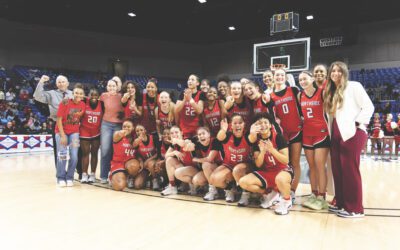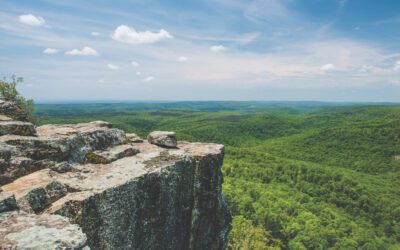[title subtitle=”WORDS Dwain Hebda
IMAGES courtesy Arkansas Colleges of Health Education”][/title]
Fort Smith’s First Medical Presence, surgeon Thomas Russell, arrived in 1817 with the original company of riflemen who founded the wilderness outpost that would grow into Arkansas’ second-largest city. One hundred ninety-seven years later, the Arkansas Colleges of Health Education stood its own post and looked out upon a different kind of frontier – one dominated by medical technology, shifting health-care policy and of late, a viral crisis of global proportions.
Since that day in 2014, the challenging health-care landscape has been more fuel than damper for the group’s mission. Seeing the growth that the organization has enjoyed over the past six years, it’s obvious ACHE has tapped into a vein near the bursting point.
“Our next year’s class is full,” says Kyle Parker, CEO. “We had over five thousand applications for one hundred and fifty seats. We give emphasis to our region and that would be not just Arkansas, but also contiguous states. Historically about sixty seven percent of our kids are from this region.”
Arkansas Colleges of Health Education is the governing organization for several medical schools. The first, Arkansas College of Osteopathic Medicine, began teaching students in 2017, and was followed by a one-year Masters of Science in Biomedicine program in 2019. All told, the four-year medical school is home to six hundred students.
ACHE just completed the home of the second college in its lineup, a 66,000-square-foot structure to house the College of Health Sciences comprised of the schools of Occupational Therapy, Physical Therapy and Physician Assistant Studies. The schools are currently undergoing accreditation, with PT expected to begin classes next year and OT in 2022.
The rapid growth and overwhelming demand for spots within the medical schools makes one wonder why class sizes are limited to just one hundred fifty spots. In part, Kyle says, it’s because class size is set by accreditation guidelines, which allow for schools to grow seats as they get more time under their belt.
But there’s a bigger, more mission-based argument for restricting class sizes too, he says. “Where the big difference comes in in the medical profession going into (students’) third and fourth year, when you put them on clinical rotations,” he says. “There are specific accrediting standards that require no more than X number of students per physician in a given core subject matter.
“When students are out, they’re typically on thirty-day rotations. For thirty days, they’ll go to a dermatologist, for thirty days they go to OB-GYN, thirty days they go to all these different subspecialties, typically four med students for one physician. Going from one hundred and fifty to two hundred students means we’ve got to find more physicians who are taking students. Logistically, that’s very difficult.”
Kyle said while theres no shortage of doctors nationwide, a complicating factor comes from the school’s desire to send students to rotations within the Arkansas- Oklahoma-Missouri footprint. He said this is a critical component of ACHE’s mission to keep students at home following their medical training.
“When you look at Arkansas right now, the current ratio is six thousand citizens for every one doctor in the state. And when you look at primary care physicians in Arkansas, a third are over the age of sixty,” Kyle says. “It’s predicted in the next five years that number is going to grow to ten thousand residents per one physician in the state of Arkansas. It is a major, major problem and that’s what we’re hoping to help address.
“Eighty percent of medical students will end up within an hour to an hour and a half of where they went through residency. That’s why location is so important. We just recently announced the signing of forty-eight residents right here in Fort Smith. We’ve already got ninety-six over at Unity in Searcy. We’ve got CHI St. Vincent down in Hot Springs and we’ve also recently filed with a hospital in Poplar Bluff, Missouri.
“We’re setting up right now to keep every one of those students in this region and with an eighty percent stick rate, I think we’ve got a pretty good chance at keeping them here.”
Like most every educational institution, the school has switched to an all-online format during the current COVID-19 crisis, something Kyle sees as a very short-term patch. He says while technology is rampant in medicine, it can only go so far in medical school. “There’s been some questions about introducing more and more online-type courses,” he says. “The problem with that is, for example anatomy, you can do it virtually but there’s nothing like being able to actually feel the various muscles and veins and cartilage. You really can’t do that very well through virtual reality.
You can expand it and drill down and that kind of stuff, but until you really get to touch it and see what it feels like to reach in behind and grab that torn ACL, if I’m going to be a surgeon, I really need that hands-on experience.”
Kyle also says while COVID-19 doesn’t cover any new ground from an infectious disease perspective, the ongoing effort to manage the outbreak provides a valuable real-world classroom. “I don’t think it changes the instruction on infectious diseases, because that’s covered today. That’s how these doctors who are out there working on this knew how to do it in the first place because they got taught how in medical school,” he says.
“There’s always silver linings in dark clouds and this one to me is the ability for our students to deal with what they may never see again in their lifetime, a pandemic. Whether or not SARS and Ebola and the bird flu were considered pandemics or not, they passed very quickly. Here, our students are being able to see situations where there’s an inordinate amount of people that potentially could be affected.”
Sitting as it does on more than four hundred acres in the Chaffee Crossing District, the organization has a lot of room to grow. Kyle wouldn’t rule out satellite schools either, although at present there’s plenty of work to do right here. It all comes down to priorities, he says, and striking the balance between reasonable safety in the pandemic and fearlessly teaching quality of care. “I think it comes down to logistics,” he says. “That’s really where I see the change taking place. We know how to protect ourselves as much as possible, but you can’t just create a bubble, and everybody wear a bubble and walk around in life. You have to take the most reasonable way of doing something without taking it to such an extreme that you can no longer do your job.
“Human beings are community-oriented people and we desire to be around other people. There’s something special about human touch, not only the ability to diagnose things, but when a doctor puts their hands on your shoulder and tells you that they understand what you’re going through, it’s very different than looking at you on a TV screen.”
HOW TO HELP
Due to the COVID-19 pandemic, Arkansas Colleges of Health Education’s annual fundraiser gala “On Call – An Evening Under the Pines,” has been postponed. As a non-profit 501(c)(3) entity, ACHE depends on community support to help fund its educational programs. To make a donation, please contact Jackie Krutsch, executive director of development, at 479.308.2295.
Arkansas Colleges of Health Education
7000 Chad Colley Boulevard
Fort Smith, Arkansas
479.308.2243 / acheedu.org




